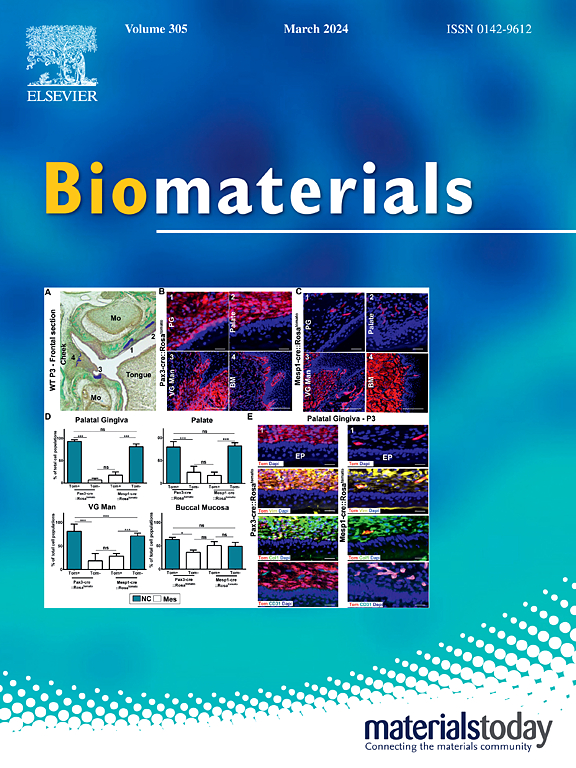CCR2-targeted nanoparticles combined with sonodynamic therapy attenuates the acute rejection of heart transplants
IF 12.9
1区 医学
Q1 ENGINEERING, BIOMEDICAL
引用次数: 0
Abstract
Donor heart-resident C–C chemokine receptor 2 (CCR2+) macrophages induce the recruitment of CCR2+ monocytes to a transplanted hearts through the secretion of monocyte chemoattractant protein-1 (MCP-1), which mediates the incidence of acute rejection (AR). In this study, we synthesized MCP-1 peptide-modified polyethylene glycol-poly (lactic-co-glycolic) acid (PEG-PLGA) nanoparticles loaded with the sonosensitizer dihydroporphyrin e6 (Ce6) and administered them via intramyocardial injection and used in combination with sonodynamic therapy (SDT) to selectively deplete donor cardiac-resident and infiltrating CCR2+ macrophages. In vitro experiments confirmed that Ce6-NP-MCP-1 targets and has chemotactic effects on CCR2+ macrophages, thereby enhancing the therapeutic efficacy of STD. In mouse heart grafts, the chemotactic effect of Ce6-NP-MCP-1 on CCR2+ macrophages has been used to induce donor heart-resident and infiltrating CCR2+ macrophages to aggregate and phagocytose nanoparticles in combination with SDT to induce macrophage apoptosis. This therapy inhibits the number of donor heart-resident CCR2+ macrophages and downregulates the expression of proinflammatory cytokines and inflammatory infiltration. In addition, it significantly prolongs the allograft survival time. Therefore, CCR2-targeted nanoparticles combined with SDT for the selective depletion of donor heart-resident CCR2+ macrophages provide a promising paradigm for AR target treatment.

靶向ccr2纳米颗粒联合声动力治疗可减轻心脏移植急性排斥反应
供体心脏C-C趋化因子受体2 (CCR2+)巨噬细胞通过分泌单核细胞趋化蛋白-1 (MCP-1)诱导CCR2+单核细胞募集到移植心脏,介导急性排斥反应(AR)的发生。在这项研究中,我们合成了MCP-1肽修饰的聚乙二醇-聚(乳酸-羟基乙酸)酸(PEG-PLGA)纳米颗粒,并将其负载声敏剂二氢卟啉e6 (Ce6),通过心肌内注射给药,并与声动力疗法(SDT)联合使用,以选择性地消耗供体心脏内的和浸润的CCR2+巨噬细胞。体外实验证实Ce6-NP-MCP-1靶向CCR2+巨噬细胞并具有趋化作用,从而增强STD的治疗效果。在小鼠心脏移植中,利用Ce6-NP-MCP-1对CCR2+巨噬细胞的趋化作用,诱导供体心脏驻留和浸润的CCR2+巨噬细胞聚集并吞噬纳米颗粒,联合SDT诱导巨噬细胞凋亡。该疗法抑制供体心脏常驻CCR2+巨噬细胞的数量,下调促炎细胞因子的表达和炎症浸润。此外,它还能显著延长同种异体移植物的存活时间。因此,CCR2靶向纳米颗粒联合SDT选择性清除供体心脏CCR2+巨噬细胞为AR靶向治疗提供了一种有希望的范例。
本文章由计算机程序翻译,如有差异,请以英文原文为准。
求助全文
约1分钟内获得全文
求助全文
来源期刊

Biomaterials
工程技术-材料科学:生物材料
CiteScore
26.00
自引率
2.90%
发文量
565
审稿时长
46 days
期刊介绍:
Biomaterials is an international journal covering the science and clinical application of biomaterials. A biomaterial is now defined as a substance that has been engineered to take a form which, alone or as part of a complex system, is used to direct, by control of interactions with components of living systems, the course of any therapeutic or diagnostic procedure. It is the aim of the journal to provide a peer-reviewed forum for the publication of original papers and authoritative review and opinion papers dealing with the most important issues facing the use of biomaterials in clinical practice. The scope of the journal covers the wide range of physical, biological and chemical sciences that underpin the design of biomaterials and the clinical disciplines in which they are used. These sciences include polymer synthesis and characterization, drug and gene vector design, the biology of the host response, immunology and toxicology and self assembly at the nanoscale. Clinical applications include the therapies of medical technology and regenerative medicine in all clinical disciplines, and diagnostic systems that reply on innovative contrast and sensing agents. The journal is relevant to areas such as cancer diagnosis and therapy, implantable devices, drug delivery systems, gene vectors, bionanotechnology and tissue engineering.
 求助内容:
求助内容: 应助结果提醒方式:
应助结果提醒方式:


